甘肃省贫困农村地区5岁以下儿童营养不良和贫血状况调查
甘肃省贫困农村地区5岁以儿童营养不良和贫血状况调查
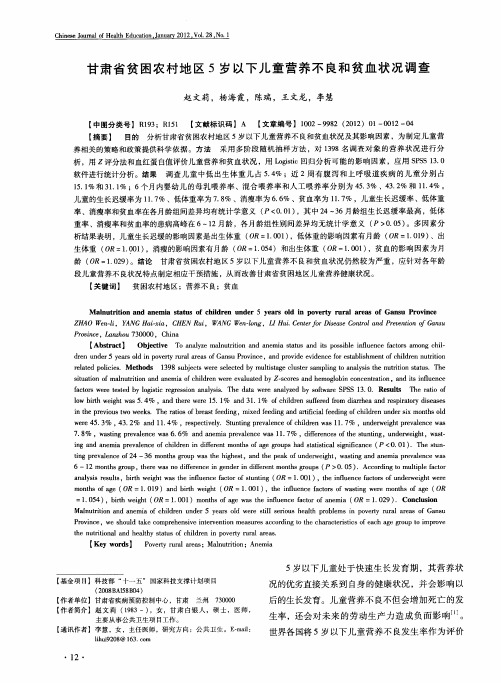
析 ,用 z评分法 和血红蛋 白值评价儿童营养和贫血 状况 ,用 L gsc回归分析可 能 的影 响因素 ,应用 S S 3 0 oii t P S1. 软件进行统计分析。结果 调查 儿童 中低 出生 体重 儿 占 54 ;近 2周有 腹泻 和 上呼 吸道 疾病 的 儿童 分别 占 .% 1 .% 和 3 . % ;6个月 内婴 幼儿 的母 乳 喂养率 、? 合 喂养 率和人 工喂养 率分 别为 4 . % 、4 . % 和 1 . % 。 51 11 昆 53 32 14 儿童 的生长迟缓率为 1 .% 、低体重率为 7 8 、消瘦率 为 6 6 、贫血率 为 1. % ,儿童生长迟缓率 、低体重 17 .% .% 17
C ie eJu a fHelhEd cto Jn ay2 2, 12 No 1 h n s o r lo at u ain,a u r 01 Vo. 8, . n
甘肃 省 贫 困农 村地 区 5岁 以T J 童 营 养不 良和贫 血 状况 调查 L
赵 文莉 ,杨 海霞 ,陈瑞 ,王文 龙 ,李慧
r a dp lis e t oce.Meh d 19 u j t w r sl t ym ls g ls r a pigt aa s en tt ns ts h le i to s 3 8sb c ee e ce b utt ec t m l n yit uri t u.T e es e d ia ues n o l sh io a
农村义务教育学生营养改善计划实施前的现状分析和政策建议——来自西北122所贫困农村小学的调查

村 有一些 寄宿制学校 的寄宿条件有限 ,无法给学 生提供足够营
养 的午餐 , 住校生 的生长发育状况 明显赶不上非住校生 。
计划中 , 如何真正有效地使用好投入 的资金意义重大。 然而 , 提高 了农村义务教育学生的营养健康 的补贴 , 是否就 能够解决农村儿童的营养健 康问题呢?中央财政 的 10多亿元 6 资金划拨到 6 0个县( ) 8 市 的农村 小学 , 校长 、 老师和家长又该如 何利用好这笔补贴 , 有效地改善农村儿童营养健康状况呢?已有
不合 理的饮食会导致 诸如缺铁性贫血 等一系列 营养 问题 。
从 而对学生的学 习造成不利影响【 贫血是 由于长期缺乏铁元 5 l 。
素摄人 , 阻碍儿童体内血红蛋白的形成 , 导致血液 中红血球 向人 体各器官和大脑输送氧气不足 。贫血会 对儿童的身心健康成长 产生不可逆转的负面影响目 。大量 的研究指 出, 血儿童的认知 贫
收稿 日期 z0 1 l — 4 2 l一 2 2
研究表 明,父母受教育水平越高 、接受的营养健康知识培训越
多 , 么就越能养育出营养健康水平高的小孩 _ 由此可以推 那 l日 。 5 l
基金项 目: 国家 自然科学基金重点项 目“ 基于城乡协调发展 的农村公共物品管理研究 ”7 0 3O ) ( 13 O 3 作者简介 : 史耀疆 , , E 男 西j 大学经济管理学院教授 、 博士生导师 , 西北社会经济发展研究中心主任 , 研究方向为农村治理与农村发展 ; 王欢 , , 女 西 北大学西北社会经济发展研究中心博士生 , 研究方 向为农村教育与农村发展 ; 田民正 。 , 男 西北大学西北社会经济发展研究 中心博 士生, 研究 方向为农 村教育 ; 杨斌 . . { 男 西j 大学西北 社会经济发展研究 中心博士生, : 研究方 向为农村教育 ; 矗, , 杨 男 西北大学西北社会经济发展研究 中心博士 生 , 究方向 研
西部贫困地区农村留守儿童生存现状的调查研究报告——以甘肃省积石山县为例

实施情况 , 以及其对当地教育的影响 ; 留守儿童所 占的 比例 、 状 、 现 存在 的 问题 以及政 府 部 门所 采 取
童学习方面作用发挥得如何等 ; 留守儿童的情感
方面 , 包括 监 护人是 否 与 留守 儿 童谈 心 、 护人 与 监
[ 基金项 目] 甘肃省 20 年社科规划项 目, 07 受香港乐施会 资助。 [ 作者简介] 邓红 (90 , , 17 一)女 江苏南京人 , 师, 士 ; 讲 博 王辉(94 , , 18 一)男 甘肃陇南 人 , 硕士研 究生 ; 辉(92 , , 王旭 18 一)男 甘肃陇南
据不完全统计 , 我国 目前有 1 5 . 亿农 民外 出 打工 , 其中能够随父母进城的儿童只 占极少数 , 绝 大部分被留守在户籍所在地生 活、 接受教育 。全 国农村 目 前有留守儿童 20 00多万 , 并且每年呈递 增的趋势。尤其是在 我国西部农村地区 , 由于多 种原因, 其留守儿童的数量尤为庞大 , 问题 日 益突 出, 受到社会有关部 门的关注和研究。 本文所指的“ 留守儿童” 指在甘肃农村贫困地
人, 中学二级教 师。
一
数 寅 一
・ 7・
维普资讯
20 0 8年 第 5期 ( 第 1 1 ) 总 7 期
留守 儿童 相处 得 怎样 、 母 在 与 不 在 留守 儿 童 的 父 表 现有何 不 同等 。
( ) 二 调查 研究方 法
缺乏保障。留守儿童不能按时保质吃饭 , 营养状
况不 良, 响儿 童的精神 状态 和上学 读书 的情绪 。 影 ( ) 习方 面 二 学
导 2人 、 长 2人 、 校 教导 主Leabharlann 1 )教 师 7人 , 人 , 监
幼儿膳食营养健康调查报告
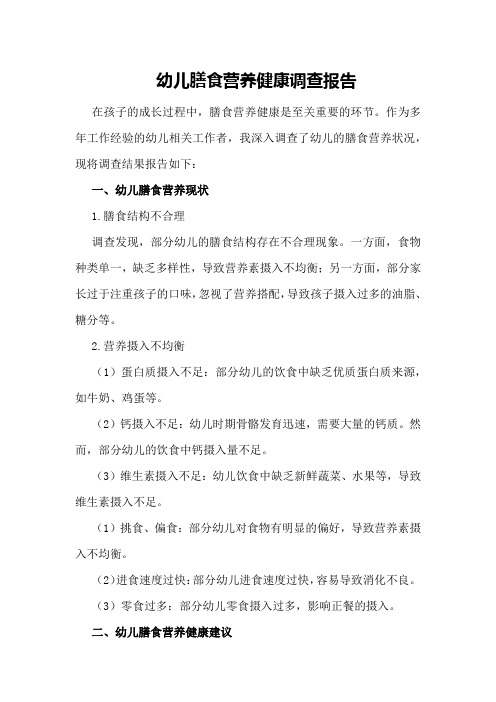
幼儿膳食营养健康调查报告在孩子的成长过程中,膳食营养健康是至关重要的环节。
作为多年工作经验的幼儿相关工作者,我深入调查了幼儿的膳食营养状况,现将调查结果报告如下:一、幼儿膳食营养现状1.膳食结构不合理调查发现,部分幼儿的膳食结构存在不合理现象。
一方面,食物种类单一,缺乏多样性,导致营养素摄入不均衡;另一方面,部分家长过于注重孩子的口味,忽视了营养搭配,导致孩子摄入过多的油脂、糖分等。
2.营养摄入不均衡(1)蛋白质摄入不足:部分幼儿的饮食中缺乏优质蛋白质来源,如牛奶、鸡蛋等。
(2)钙摄入不足:幼儿时期骨骼发育迅速,需要大量的钙质。
然而,部分幼儿的饮食中钙摄入量不足。
(3)维生素摄入不足:幼儿饮食中缺乏新鲜蔬菜、水果等,导致维生素摄入不足。
(1)挑食、偏食:部分幼儿对食物有明显的偏好,导致营养素摄入不均衡。
(2)进食速度过快:部分幼儿进食速度过快,容易导致消化不良。
(3)零食过多:部分幼儿零食摄入过多,影响正餐的摄入。
二、幼儿膳食营养健康建议1.合理搭配膳食结构(1)增加蛋白质摄入:适当增加牛奶、鸡蛋、豆腐等优质蛋白质来源。
(2)增加蔬菜、水果摄入:确保孩子每天摄入足够的蔬菜和水果,以补充维生素和矿物质。
(3)控制油脂、糖分摄入:减少油炸、高糖食物的摄入,以免影响孩子的生长发育。
(1)定时定量:养成定时定量的进食习惯,避免暴饮暴食。
(2)细嚼慢咽:教育孩子细嚼慢咽,避免进食过快导致消化不良。
(3)合理零食:适当给孩子提供健康的零食,如坚果、水果等。
3.家庭与幼儿园共同配合(1)加强沟通:家长与幼儿园教师加强沟通,了解孩子在园的饮食情况,共同调整饮食结构。
(2)开展教育活动:幼儿园可以开展相关的教育活动,引导孩子树立正确的饮食观念。
(3)定期体检:定期对孩子进行体检,了解其营养状况,及时调整饮食。
幼儿膳食营养健康调查报告有时候,家长们可能在忙碌的生活中忽略了孩子的饮食细节。
比如,有的家长认为只要孩子能吃,就是健康的,却忽视了食物的营养价值。
甘肃省流动儿童状况调查报告

四 要 提 高 应 对 突 发 事 件 的 能 力 。新 的 历 史时 期 , 联 妇
技 术 快速 发展 , 国现 有 网 民 中 4 7亿 ,博 客 用 户 2 5亿 , . 5 . 9 互
展 部巡 视 员 )
( 责任 编 辑 王 秀英 )
焉
地 考 察 等 形 式 , 流 动 儿 童 学 对 习 、生 活 和 健 康 状 况 进 行 调
人 际 交 往 能 力 较 差 , 易 与 他 容
人 发 生 冲突 。流 动 儿 童 自我保
人, 占兰 州 市 义 务 教 育 阶 段 在 校 生人 数 的 1. %。 5 1 6 嘉峪 关市 流 动 儿 童 占 当 地 义 务 教 育 阶
段 在 校 生 比 例 最 高 , 达 到 2 .l 05 %。流 动 儿 童 居住 区主 要
研。
儿 童 营 养 状 况 水 平 明 显 低 于 户籍 儿 童 。三 是 流 动 儿 童 卫生
独心理强烈 。 不断变换的生 在
活 学 I 环 境 中 , 动 儿 童很 难 ] 流 确 立 和 维 持 一 个 稳 定 的 社 会
群 体 , 而 使 这 些 孩 子 在 思 维 从 中很 难 形 成 “ 会 人 ” 概 念 , 社 的
独 心 理 , 不 到 归 属 感 。三 是 找
众 ,教 育 部 门管 理 入 学 儿 童 , 卫 生 部 门 管 理 参 加 儿 童 保 健
和 计 划 免 疫 的 流 动 儿 童 , 埘 而 1 6岁 以 下 大 多 数 未 参 加 儿 童 保 健 和 计 划 免 疫 的 流 动 儿 童 卫 生 保 健 管 理 存 在空 白 。
人 , 中义 务 教 育 阶 段 流 动 儿 其 童 总 数 为 19 7 7 6 5人 ,并 呈 现
农村地区6个月~7岁儿童贫血及铁缺乏情况调查及干预
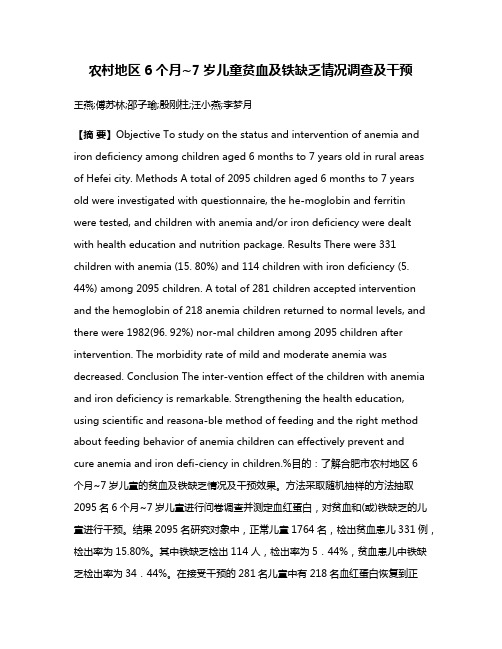
农村地区6个月~7岁儿童贫血及铁缺乏情况调查及干预王燕;傅苏林;邵子瑜;殷刚柱;汪小燕;李梦月【摘要】Objective To study on the status and intervention of anemia and iron deficiency among children aged 6 months to 7 years old in rural areas of Hefei city. Methods A total of 2095 children aged 6 months to 7 years old were investigated with questionnaire, the he-moglobin and ferritin were tested, and children with anemia and/or iron deficiency were dealt with health education and nutrition package. Results There were 331 children with anemia (15. 80%) and 114 children with iron deficiency (5. 44%) among 2095 children. A total of 281 children accepted intervention and the hemoglobin of 218 anemia children returned to normal levels, and there were 1982(96. 92%) nor-mal children among 2095 children after intervention. The morbidity rate of mild and moderate anemia was decreased. Conclusion The inter-vention effect of the children with anemia and iron deficiency is remarkable. Strengthening the health education, using scientific and reasona-ble method of feeding and the right method about feeding behavior of anemia children can effectively prevent andcure anemia and iron defi-ciency in children.%目的:了解合肥市农村地区6个月~7岁儿童的贫血及铁缺乏情况及干预效果。
2023年困境儿童调查报告
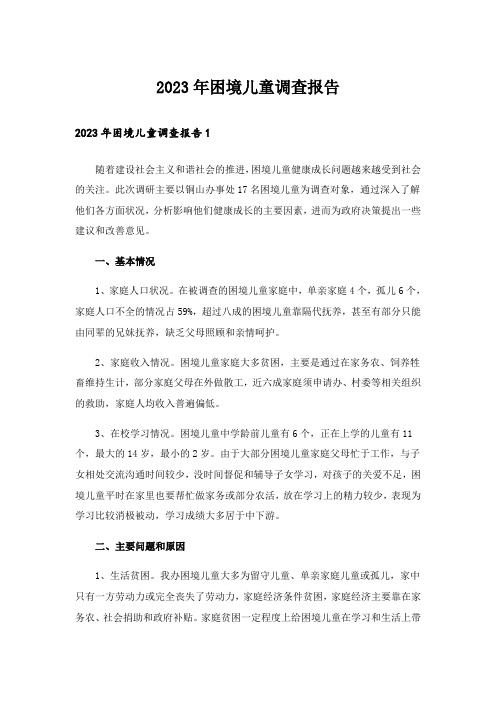
2023年困境儿童调查报告2023年困境儿童调查报告1随着建设社会主义和谐社会的推进,困境儿童健康成长问题越来越受到社会的关注。
此次调研主要以铜山办事处17名困境儿童为调查对象,通过深入了解他们各方面状况,分析影响他们健康成长的主要因素,进而为政府决策提出一些建议和改善意见。
一、基本情况1、家庭人口状况。
在被调查的困境儿童家庭中,单亲家庭4个,孤儿6个,家庭人口不全的情况占59%,超过八成的困境儿童靠隔代抚养,甚至有部分只能由同辈的兄妹抚养,缺乏父母照顾和亲情呵护。
2、家庭收入情况。
困境儿童家庭大多贫困,主要是通过在家务农、饲养牲畜维持生计,部分家庭父母在外做散工,近六成家庭须申请办、村委等相关组织的救助,家庭人均收入普遍偏低。
3、在校学习情况。
困境儿童中学龄前儿童有6个,正在上学的儿童有11个,最大的14岁,最小的2岁。
由于大部分困境儿童家庭父母忙于工作,与子女相处交流沟通时间较少,没时间督促和辅导子女学习,对孩子的关爱不足,困境儿童平时在家里也要帮忙做家务或部分农活,放在学习上的精力较少,表现为学习比较消极被动,学习成绩大多居于中下游。
二、主要问题和原因1、生活贫困。
我办困境儿童大多为留守儿童、单亲家庭儿童或孤儿,家中只有一方劳动力或完全丧失了劳动力,家庭经济条件贫困,家庭经济主要靠在家务农、社会捐助和政府补贴。
家庭贫困一定程度上给困境儿童在学习和生活上带来了一些影响,而儿童时期正是身体发育的黄金时期,家庭贫困甚至影响到了困境儿童的身体健康。
2、学习消极。
家长的教育能力与孩子教育需求之间成正比。
外出务工的家长忙于打工,在家的父母或其他监护人忙于操持家务,都没有时间与精力过问孩子的学习,对孩子的需求、兴趣、交往、困惑等关注极少,不能及时、充分地给予他们精神上的支持和知识上的解答,导致了一些困境儿童学习成绩跟不上。
而困境儿童因家庭环境常分散学习精力,课堂上注意力不集中,学习跟不上,可能产生厌学情绪。
新庄镇0~7岁儿童“钙缺乏及相关疾病”调查报告

新庄镇0~7岁儿童“钙缺乏及相关疾病”调查报告2005年7月5~19日,新庄卫生院协助“甘肃省‘千名医师支援农村卫生工程’驻宁县医疗队新庄卫生院分队”,共6人分3组,采用入户访视的形式,对新庄卫生院辖区0~7岁儿童进行普查。
资料与方法全镇被调查儿童共计16.52名,覆盖率86.90%,普查项目分为盗汗、手足搐搦、方颅、串珠胸、鸡胸及漏斗胸和佝偻病等6个症候群进行。
被调查的1652名儿童中,男童共891名(54.53%),女童共751名(45.47%)。
结果各组症候群发病情况见表2。
全镇0~7岁儿童钙缺乏及相关疾病发生率高达62.72%,其中男、女童发病分别为819名和833名,占被调查儿童的49.58%和50.42%,无明显差异。
在各组症候群中,主要表现为盗汗、手足搐搦等轻度损害,分别检出914例(55.33%)和741例(44.85%);方颅、串珠胸等中度损害较普遍,分别检出434例(26.72%)和250例(15.13%);而鸡胸及漏斗胸、佝偻病较少见,分别检出12例(0.73%)和6例(0.36%),差异较明显;其中只检出1组症状的共496例(30.02%),检出2组症状的共827例(50.06%),检出3组以上症状的329例(19.92%)。
各年龄组中,1岁组阳性检出率最高,共108例(65.45%);4岁组阳性检出率最低,共124例(61.08%),差异不显著。
在所有阳性组儿童中,大约只有480名儿童(29.06%)进行过相关检查和规范治疗。
讨论建议卫生院制定《新庄镇卫生院“钙缺乏及相关疾病”防治预案》,建立农村儿童健康干预的长效机制:①孕期孕妇营养状况直接影响胎儿的正常生长发育,应该建议孕妇重视妊娠中期的预防工作,通过宣传、动员孕妇在妊娠中期(妊娠6~8个月)多食钙含量较高的食物,或及时补充钙剂,防止新生儿钙缺乏症及其不良后果。
可通过口服钙中钙片每次2片,每日3次,或高钙片,每次1片,每日3次,葡萄糖酸钙口服液,每次10ml,每日3次,同时加服多种维生素糖丸,每次1丸,每日3次,连续3个月,鼓励孕妇多进行阳光浴、增加户外活动等,并避免高盐饮食、酗酒、吸烟、碳酸饮料等的摄入,直至孕妇腰酸腿软、抽搐、小腿肚转筋等症状消失,但需注意防止补钙过激造成新生儿小头畸形、囟门过早愈合症的发生。
甘肃省人民政府办公厅关于实施农村义务教育学生营养改善计划的意见-甘政办发[2012]27号
![甘肃省人民政府办公厅关于实施农村义务教育学生营养改善计划的意见-甘政办发[2012]27号](https://img.taocdn.com/s3/m/4f5e6d2ea22d7375a417866fb84ae45c3b35c2c9.png)
甘肃省人民政府办公厅关于实施农村义务教育学生营养改善计划的意见正文:---------------------------------------------------------------------------------------------------------------------------------------------------- 甘肃省人民政府办公厅关于实施农村义务教育学生营养改善计划的意见(甘政办发〔2012〕27号2012年2月8日)各市、自治州人民政府,省政府有关部门:为全面贯彻落实《国务院办公厅关于实施农村义务教育学生营养改善计划的意见》(国办发〔2011〕54号),进一步改善我省农村学生营养状况,提高农村学生尤其是贫困地区和家庭经济困难学生健康水平,现就我省实施农村义务教育学生营养改善计划提出以下意见:一、深刻认识实施农村义务教育学生营养改善计划的重要意义省委、省政府历来高度重视青少年的健康成长,先后采取了一列有效措施,不断改善农村义务教育学生学习生活条件。
特别是2006年农村义务教育经费保障机制改革实施以来,我省全面免除了农村义务教育阶段学生的学杂费,并对家庭经济困难寄宿生给予生活费补助(以下简称“一补”政策),为提高农村学生营养健康水平打下了坚实的基础,但由于我省地处西部,城乡经济社会发展不平衡,广大农村学生及家长的营养知识较为缺乏,农村中小学生仍然存在着营养不良等问题,贫困地区尤为突出。
实施农村义务教育学生营养改善计划,是坚持以人为本,全面贯彻落实科学发展观的具体体现,是改善农村学生营养状况,提高农村学生健康水平的有效途径,是促进教育公平,建设人力资源强省的重要举措,对促进农村义务教育阶段学生健康成长具有十分重要的意义。
各市州、县市区政府及省政府各有关部门要统一思想,提高认识,切实按照省政府的决策部署,扎实做好营养改善计划实施工作。
二、农村义务教育学生营养改善计划的主要内容按照“省级统筹,以县为主,试点先行,稳步推进”的原则,认真实施农村义务教育学生营养改善计划,不断提高农村义务教育学生营养健康水平。
农村儿童营养与健康问题的调查与改善策略社会实践报告

农村儿童营养与健康问题的调查与改善策略社会实践报告社会实践报告一、调查背景近年来,农村儿童的营养与健康问题备受关注。
由于农村地区经济条件相对较差,饮食结构单一,营养不均衡的问题逐渐凸显。
为了解决这一问题,我们进行了一次农村儿童营养与健康问题的调查,并提出改善策略。
二、调查方法我们选取某县乡村小学的小学生作为研究对象,共计调查了200名儿童。
通过问卷调查、生理指标测量和膳食记录等方法,我们获取了大量的数据,并进行了分析和总结。
三、营养状况调查结果1. 营养摄入不足通过问卷调查和膳食记录,我们发现绝大多数农村儿童的所摄入的热量和营养素都远低于国家标准推荐摄入量。
特别是蛋白质和微量元素的摄入量普遍不足,导致儿童发育延迟和免疫力下降。
2. 膳食结构不合理农村地区的饮食结构以主食为主,蔬菜和水果摄入量较少。
大量人群沉迷于高盐、高油、高糖的饮食习惯,导致肥胖和慢性病的发病率逐年增加。
3. 生长发育不良在体格测量中,我们发现部分儿童体重与身高的生长指标明显低于同龄人的标准。
这也印证了营养不良对农村儿童生长的不利影响。
四、改善策略1. 加强营养教育针对农村儿童和家长的营养知识缺乏情况,应加强营养教育。
学校可开展营养课程,向学生传授正确的饮食常识和膳食搭配方法。
同时,鼓励学校与家长合作,共同促进儿童健康成长。
2. 优化膳食结构饮食结构应更加均衡,提供蛋白质、维生素、矿物质等营养素。
政府可以通过农村补贴政策,鼓励农民种植蔬菜和水果,并规划农村地区配餐中心,提供均衡饮食。
3. 强化体育锻炼体育锻炼是促进儿童健康成长的重要环节,对农村儿童更为重要。
学校和社区应提供多样化的体育活动,组织集体运动,并根据不同年龄群体的特点合理安排运动时间。
4. 加大政策支持力度政府应加大对农村儿童营养与健康问题的关注,制定相关政策并加以落实。
同时,加大投入,完善农村地区基础设施建设和医疗资源,提高农村地区儿童的健康水平。
五、结语通过本次调查,我们深刻认识到农村儿童营养与健康问题的严重性。
甘肃省教育厅关于进一步做好农村义务教育学生营养改善计划有关工作的通知-甘教厅[2013]1号
![甘肃省教育厅关于进一步做好农村义务教育学生营养改善计划有关工作的通知-甘教厅[2013]1号](https://img.taocdn.com/s3/m/a2cf6607b6360b4c2e3f5727a5e9856a56122602.png)
甘肃省教育厅关于进一步做好农村义务教育学生营养改善计划有关工作的通知正文:---------------------------------------------------------------------------------------------------------------------------------------------------- 甘肃省教育厅关于进一步做好农村义务教育学生营养改善计划有关工作的通知(甘教厅〔2013〕1号)各市(州)和58个连片特困县(市、区)教育局:农村义务教育学生营养改善计划(以下简称营养改善计划)实施一年来,有关市(州)、县(市、区)积极探索,各项工作稳步推进,取得了显著成效,得到了人民群众的衷心拥护,受到了社会各界的广泛好评。
但在实施过程中也存在政策落实不到位、操作形式简单、基础工作滞后、宣传力度不够等问题。
为解决这些问题,确保营养改善计划的实施成效,把好事办好,实事办实,根据全国学生营养办《关于进一步做好农村义务教育学生营养改善计划有关工作的通知》(全国学生营养办〔2012〕2号),现就进一步做好有关工作通知如下:一、切实落实地方责任一是完成“规定动作”。
市(州)、县(市、区)教育部门要认真贯彻落实国办发〔2011〕54号文件和甘政办发〔2012〕27号文件要求,加大组织指导力度,扎实推进实施工作。
要出台具体政策,将因实施营养改善计划增加的食堂聘用人员工资、食品配送费用等纳入当地财政妥善解决,不得挤占学校公用经费,更不能挤占国家膳食补助。
二是做好统筹。
市(州)、县(市、区)教育部门要做好“加法”,防止产生“挤出”效应。
要统筹家庭经济困难寄宿生生活费补助、各类针对农村孩子的扶贫项目补助、社会捐赠赞助等,妥善解决农村义务教育学生在校就餐问题,逐步改善学生膳食营养状况。
三是对边远困难地区和学校给予特殊支持。
对交通不便、没有食堂且规模较小的村小和教学点,“留守儿童”较为集中的学校,生活习俗特殊的民族地区学校,要在充分听取当地学生、家长意见的基础上,按照“一校一策”原则制订有针对性的供餐方案。
中国儿童贫困问题调查报告
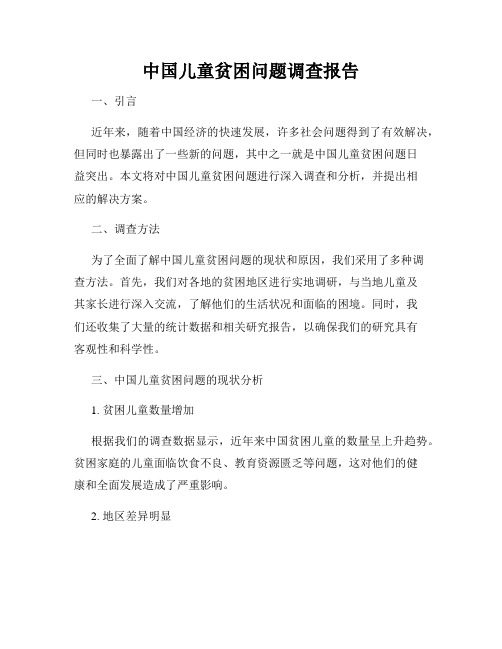
中国儿童贫困问题调查报告一、引言近年来,随着中国经济的快速发展,许多社会问题得到了有效解决,但同时也暴露出了一些新的问题,其中之一就是中国儿童贫困问题日益突出。
本文将对中国儿童贫困问题进行深入调查和分析,并提出相应的解决方案。
二、调查方法为了全面了解中国儿童贫困问题的现状和原因,我们采用了多种调查方法。
首先,我们对各地的贫困地区进行实地调研,与当地儿童及其家长进行深入交流,了解他们的生活状况和面临的困境。
同时,我们还收集了大量的统计数据和相关研究报告,以确保我们的研究具有客观性和科学性。
三、中国儿童贫困问题的现状分析1. 贫困儿童数量增加根据我们的调查数据显示,近年来中国贫困儿童的数量呈上升趋势。
贫困家庭的儿童面临饮食不良、教育资源匮乏等问题,这对他们的健康和全面发展造成了严重影响。
2. 地区差异明显中国儿童贫困问题在不同地区之间存在明显差异。
贫困地区集中在西部地区和少数民族聚居地,由于地理、经济和文化环境的影响,这些地区的儿童更容易受到贫困的影响。
3. 贫困家庭结构复杂贫困家庭的结构复杂多样,有单亲家庭、农民工子女家庭等。
这些家庭通常存在经济困难、亲子关系不稳定等问题,给儿童的成长带来了许多不利因素。
4. 教育资源不均衡贫困地区教育资源缺乏,儿童面临课堂人数过多、教学质量低下等问题。
由于教育资源不均衡,这些儿童的学习机会和未来发展受到了很大限制。
四、中国儿童贫困问题的原因分析1. 经济发展不平衡中国经济发展不平衡是导致儿童贫困问题的主要原因之一。
发达地区的经济腾飞使很多儿童受益,但贫困地区的经济发展滞后,儿童贫困问题得不到根本解决。
2. 农村城镇差距中国农村地区的经济条件相对较差,农民工子女面临教育资源匮乏、学校设施简陋等问题。
与此同时,城市儿童享有更好的教育资源和生活条件,这加剧了农村城镇差距,也使得农村儿童贫困率更高。
3. 家庭因素许多贫困家庭存在缺乏合适就业岗位、缺乏健康保障等问题,这直接影响了儿童的生活品质。
中国居民营养与健康状况调查研究报告

中国居民营养和健康情况调查汇报关键词:中国居民营养和健康情况调查汇报中国居民营养和健康现实状况(10月12日)中国卫生部中国科学技术部中国国家统计局第一部分背景一、调查目标和意义国民营养和健康情况是反应一个国家或地域经济和社会发展、卫生保健水平和人口素质关键指标。
良好营养和健康情况既是社会经济发展基础,也是社会经济发展关键目标。
世界上很多国家,尤其是发达国家均定时开展国民营养和健康情况调查,立即颁布调查结果,并据此制订和评价对应社会发展政策,以改善国民营养和健康情况,促进社会经济协调发展。
中国曾于1959年、1982年和1992年分别进行过三次全国营养调查;1959年、1979年和1991年分别开展过三次全国高血压流行病学调查;1984年和1996年分别开展过两次糖尿病抽样调查。
上述调查对于了解中国城镇居民膳食结构和营养水平及其相关慢性疾病流行病学特点及改变规律;评价城镇居民营养和健康水平;制订相关政策和疾病防治方法发挥了主动作用。
因为近十年来,中国社会经济得到了快速发展,首先为消除营养缺乏和改善居民健康提供了经济、物质基础,其次也造成了膳食结构、生活方法和疾病谱改变。
为立即了解居民膳食结构、营养和健康情况及其改变规律,揭示社会经济发展对居民营养和健康情况影响,为国家制订相关政策、引导农业及食品产业发展、指导居民采纳健康生活方法提供科学依据,8-12月,在卫生部、科技部和国家统计局共同领导下,由卫生部具体组织各省、自治区、直辖市相关部门在全国范围内开展了"中国居民营养和健康情况调查"。
这是中国首次进行营养和健康综合性调查。
它将以往由不一样专业分别进行营养、高血压、糖尿病等专题调查进行有机整合,并结合社会经济发展情况,增加了新相关指标和内容,在充足科学论证基础上,统一组织、设计和实施。
调查覆盖全国31个省/自治区/直辖市(不含香港、澳门尤其行政区及台湾),对全国和不一样类型地域含有良好代表性。
农村儿童营养不良问题深度调查[精选]
![农村儿童营养不良问题深度调查[精选]](https://img.taocdn.com/s3/m/96d10ec9c9d376eeaeaad1f34693daef5ff71348.png)
农村儿童营养不良问题深度调查[精选]第一篇:农村儿童营养不良问题深度调查[精选]农村儿童营养不良问题深度调查农村义务教育在“两免一补”等政策的落实中已大为改善,但仍存在一些让人忧心的问题,农村孩子的营养不良就是其中之一。
因为营养不良,10来岁的孩子还像个小不点“10来岁的孩子看起来还像个小不点,显然是营养不良。
”在宁夏回族自治区固原市原州区炭山乡蹲点的广东深圳市机关干部常淑安深有感触地说,她的孩子每天都要吃肉、蛋、奶,而她房东家孩子的早餐竟然是一颗撒了盐的煮马铃薯。
山大沟深、多旱少雨的宁夏南部山区是我国最为贫困的地区之一,这里农村青少年饮食单一、营养不良问题较为普遍。
2010年,当地靠天吃饭的农民年人均收入刚刚超过3000元,用于孩子营养投资的钱捉襟见肘。
每天在山路上来回奔波的孩子们,吃的早饭、午饭只是几块馍馍,寄宿的学生则日复一日重复着面条、面片搭配土豆丝、土豆块的生活。
海原县教育局副局长王宗龙说,由于摄入营养不足,不少农村中小学都出现了“第四节课”现象:饿着肚子的学生到了临近中午的第四节课时明显乏力,注意力不集中。
半月谈记者在广西壮族自治区都安瑶族自治县等部分贫困县了解到,一些住校的农村孩子日复一日吃无菜无肉的黄豆蒸米饭,有的一吃就是数年!根据我国“两免一补”政策,义务教育阶段农村贫困寄宿制学校学生可获得生活补助,2010年的新标准是小学每生每年750元,中学生每生每年1000元。
然而,当前广西使用最广泛的生活补助发放方式是以现金或通过银行转账方式,发放到学生或家长手中。
家庭的贫困和成年人对儿童营养的忽视,导致多数家长将学生“补助款”变成了家庭“扶贫款”,学生并未真正获益。
2010年,中国发展研究基金会先后在青海、云南、广西和宁夏等西部地区开展调查,发现贫困农村学生营养不良、身体发育迟缓问题比较普遍。
该基金会秘书长卢迈说:“营养不良所带来的负面影响将伴随人的一生,具有不可逆性,如果不及时加以干预,损失是未来难以弥补的。
我国5岁以下儿童营养不良状况及变化趋势_杨晓光

我国5岁以下儿童营养不良状况及变化趋势杨晓光,王志宏,何宇纳,于文涛,胡以松,翟凤英(中国疾病预防控制中心营养与食品安全所,北京 100050)【摘 要】目的:分析2002年我国5岁以下儿童营养不良状况及1992-2002年十年间的变化趋势。
方法:利用“1992全国营养调查”和“2002年中国居民营养与健康调查”中的体格测量资料,采用WHO/NCHS推荐的身高标准体重参考值作为评价标准,应用SAS软件进行统计分析。
结果:1992-2002年间,我国城市5岁以下儿童生长迟缓率由1992年的19.1%降为2002年4.9%,农村由35.0%降为14.3%;城市低体重率由18.0%降为7.8%,农村由10.1%降为3.8%。
关键词:生长发育;生长迟缓;低体重;营养不良中图分类号:R151.3文献标识码:A文章编号:0512-7955(2005)03-0185-04TRENDS AND PREVALENCE OF MALNUTRITION AMONG CHINESECHILDREN UNDER FIVE YEARS OLDYANG Xiao-guang,WANG Zhi-hong,HE Yu-na,YU Wen-tao,HU Yi-song,ZHAI Feng-ying (Institute of Nutrition and Food Safety, Chinese Center for Disease Control and Prevention, Beijing 100050, China)【Abstract】Objective:To study the trends and prevalence of malnutrition status among Chinese children under 5 years old from 1992-2002. Methods: The anthropometry data were collected from ‘National Nutrition Survey in 1992’ and ‘The Nutrition and Health Status of the Chinese People in 2002’. Age- and sex- specific height and weight reference recommended by WHO/NCHS was used to analyze the data. Result: The prevalence of stunting among urban children less than five years old decreased from 19.1% in 1992 to 4.9% in 2002, and in rural areas from 35.0% to 14.3%. In 2002, 7.8% of children in urban areas were underweight, compared to 18.0% in 1992. while in rural areas was 3.8% in 2002 compared to 10.0% in 1992.Key words:stunting underweight;growth;malnutrition身高和体重是评价儿童生长发育和营养状况常用的指标。
甘肃省卫生厅关于印发甘肃省卫生部――联合国儿童基金会母子健康综合项目实施方案的通知

甘肃省卫生厅关于印发甘肃省卫生部――联合国儿童基金会母子健康综合项目实施方案的通知文章属性•【制定机关】甘肃省卫生和计划生育委员会(原甘肃省卫生厅)•【公布日期】2012.11.05•【字号】甘卫妇社函[2012]654号•【施行日期】2012.11.05•【效力等级】地方规范性文件•【时效性】现行有效•【主题分类】未成年人保护正文甘肃省卫生厅关于印发甘肃省卫生部--联合国儿童基金会母子健康综合项目实施方案的通知(甘卫妇社函〔2012〕654号)合作市、临潭县、文县、西和县、礼县卫生局:为改善西部贫困农村地区妇女儿童的健康状况,关注孕产妇和5岁以下儿童健康,降低疾病发生率,降低孕产妇、新生儿和5岁以下儿童死亡率,进一步加强农村地区孕产妇、新生儿、儿童保健服务的提供与利用,卫生部和联合国儿童基金会决定在我国西部7个省份实施“母子健康综合项目”,项目周期为2011-2013年。
我省甘南州合作市、临潭县和陇南市文县、西和县、礼县等5个市县被确定为项目县。
项目由省妇幼保健院负责技术指导。
现将《甘肃省卫生部-联合国儿童基金会母子健康综合项目实施方案》印发你们,请遵照执行。
甘肃省卫生厅2012年11月5日甘肃省卫生部--联合国儿童基金会母子健康综合项目实施方案为全面实施好卫生部--联合国儿童基金会母子健康综合项目,促进项目地区妇幼卫生事业发展,提高各级妇幼卫生服务人员的服务水平和孕产妇、儿童对保健服务的利用能力,预防和减少疾病的发生,保护和促进儿童的生长发育,改善孕产妇和儿童健康水平。
结合我省实际,制定本实施方案。
一、项目背景“十一五”期间,在国家深化医药卫生体制改革,卫生事业持续健康发展的大环境下,我省妇幼卫生事业稳步发展,取得了显著成绩,为促进基本公共卫生服务逐步均等化、增进妇女儿童健康做出了积极贡献。
但是,我们应清楚的认识到,妇幼卫生事业在取得显著成绩的同时,也面临严峻的挑战。
妇幼卫生事业发展、妇女儿童健康状况的地区差距、城乡差距仍然明显,孕产期保健和儿童保健质量较低。
2023年儿童营养不良问题调查报告

2023年儿童营养不良问题调查报告一、调查背景为了解2023年儿童营养不良问题的现状及原因,我们组织了一次全面调查。
该调查旨在为相关部门制定针对性的政策和措施提供数据支持,以改善儿童的营养状况。
二、调查方法我们选择了开展问卷调查和实地观察的方式进行调查。
问卷采用随机抽样的方法,覆盖了全国范围内不同地区的儿童。
实地观察则选择了城市和农村地区的学校、幼儿园和家庭作为调研对象。
三、调查结果分析1. 儿童营养不良现状根据调查数据,2023年我国儿童营养不良问题仍然存在且呈上升趋势。
其中,城市地区的问题相对较小,但农村地区的儿童营养不良比例较高。
主要表现为低体重、低身高、缺铁性贫血等问题。
2. 营养不良原因分析(1)经济原因:由于农村地区的贫困程度较高,许多家庭无力提供均衡的饮食,导致儿童缺乏营养。
(2)教育原因:部分家庭对婴幼儿的饮食知识了解不足,无法提供符合营养需求的食物。
(3)饮食结构问题:现代食品市场的快餐化和便利化程度提高,导致儿童过多摄入高糖、高脂肪、高盐食物,影响了均衡饮食。
3. 营养不良影响儿童营养不良不仅会影响其身体健康,还会对智力发育、免疫力等方面产生长期影响。
长期以往,可能导致学习能力下降、身体发育不良等问题。
四、解决措施建议针对2023年儿童营养不良问题,我们提出以下解决措施建议:1. 政策层面:加大对农村地区的扶贫力度,帮助贫困家庭提高经济来源,以确保儿童获得基本的饮食保障。
2. 教育层面:加强对家长和教师的饮食教育,提高其对儿童饮食知识的掌握,促进健康饮食观念的培养。
3. 食品市场监管:加强对儿童食品市场的监管,限制营养含量低、添加剂过多的食品销售,鼓励提供健康均衡的儿童食品。
4. 家庭教育指导:推广家庭膳食指南,帮助家庭制定科学合理的膳食结构,保证儿童获得多样化的营养。
五、结语通过对2023年儿童营养不良问题的调查,我们深刻认识到该问题的严重性。
只有全社会的共同努力,才能解决儿童营养不良问题,为儿童健康成长提供良好的保障。
5岁以下儿童营养不良的调查及干预研究进展
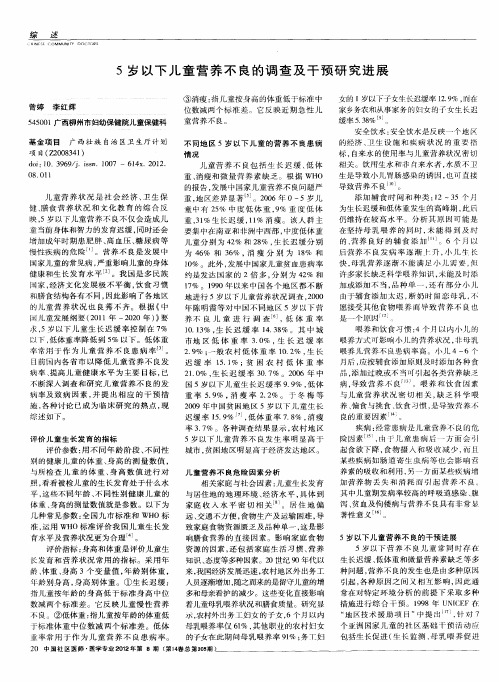
… N Fs ( M M IN1 Y Do f, 0 S E 0 】 T T
5岁 以 下 儿 童 营 养 不 良的 调 查 及 干 预 研 究 进 展
曾婷 李 红 辉
③消瘦 : 儿童按身高 的体重低于标准 中 指 位 数 减 两 个 标 准 差 它 反 映 近 期 急 性 儿
起 食欲下降 , 食物 摄入 和吸 收 减少 , 且 某些 疾 病 如 肠 道 寄 生 虫 病 等 也 会 影 响 营
养 素 的 吸 收 和 利 用 , 一 方 面 某 些 疾 病 增 另 加 营 养 物 丢 失 和 消 耗 而 引 起 营 养 不 良 其中儿童期发病率较高 的呼吸道感染 、 腹 泻 、 血 及 佝 偻 病 与 营 养 不 良具 有 非 常 贫 著 性 意 义 。 5岁 以 下 儿 童 营 养 不 良 的干 预 进 展 5岁 以 下 营 养 不 良儿 童 常 同 时 存 在 生长迟缓 、 低体 重和微量营养 素缺 乏等多 种问题 , 营养 不 良的 发 生 也 是 由 多种 原 因
生 是 导 致 小 儿 胃肠 感 染 的诱 因 , 可 直 接 也
导致 营养 不 良” 。 添加辅 食 时 间和 种类 :2~3 1 5个月 为生 长迟 缓和低体重发生 的高峰期 , 后 此
仍 维 持 在 较 高 水 平 。 分 析 其 原 因可 能 是 在 坚 持 母 乳 喂 养 的 同 时 , 能 得 到 及 时 未 的 、 养 良 好 的 辅 食 添 加 J 营 “ 。6个 月 以 后 营 养 不 良 发 病 率 逐 渐 }升 , 儿 牛 长 小 快 , 乳 营养 逐 渐 不 能 满 足 l J 需 要 , 母 hL 但 许 多 家 长 缺 乏 科 学 喂养 知识 , 能 及 时 添 未 加 或 添 加 不 当 , 种 单 一 , 有 部 分 小 儿 品 还 由于 辅 食 添 加 太 迟 , 奶 时 留 恋 母 乳 , 断 不
- 1、下载文档前请自行甄别文档内容的完整性,平台不提供额外的编辑、内容补充、找答案等附加服务。
- 2、"仅部分预览"的文档,不可在线预览部分如存在完整性等问题,可反馈申请退款(可完整预览的文档不适用该条件!)。
- 3、如文档侵犯您的权益,请联系客服反馈,我们会尽快为您处理(人工客服工作时间:9:00-18:30)。
Malnutrition and anemia status of children under 5 years old in poverty rural areas of Gansu Province ZHAO Wen-li,YANG Hai-xia,CHEN Rui,WANG Wen-long,LI Hui. Center for Disease Control and Prevention of Gansu Province,Lanzhou 730000,China
【Abstract】 Objective To analyze malnutrition and anemia status and its possible influence factors among children under 5 years old in poverty rural areas of Gansu Province,and provide evidence for establishment of children nutrition related policies. Methods 1398 subjects were selected by multistage cluster sampling to analysis the nutrition status. The situation of malnutrition and anemia of children were evaluated by Z-scores and hemoglobin concentration,and its influence factors were tested by logistic regression analysis. The data were analyzed by software SPSS 13. 0. Results The ratio of low birth weight was 5. 4% ,and there were 15. 1% and 31. 1% of children suffered from diarrhea and respiratory diseases in the previous two weeks. The ratios of breast feeding,mixed feeding and artificial feeding of children under six months old were 45. 3% ,43. 2% and 11. 4% ,respectively. Stunting prevalence of children was 11. 7% ,underweight prevalence was 7. 8% ,wasting prevalence was 6. 6% and anemia prevalence was 11. 7% ,differences of the stunting,underweight,wasting and anemia prevalence of children in different months of age groups had statistical significanБайду номын сангаасe ( P < 0. 01) . The stunting prevalence of 24 - 36 months group was the highest,and the peak of underweight,wasting and anemia prevalence was 6 - 12 months group,there was no difference in gender in different months groups ( P > 0. 05) . According to multiple factor analysis results,birth weight was the influence factor of stunting ( OR = 1. 001) ,the influence factors of underweight were months of age ( OR = 1. 019) and birth weight ( OR = 1. 001) ,the influence factors of wasting were months of age ( OR = 1. 054) ,birth weight ( OR = 1. 001) months of age was the influence factor of anemia ( OR = 1. 029) . Conclusion Malnutrition and anemia of children under 5 years old were still serious health problems in poverty rural areas of Gansu Province,we should take comprehensive intervention measures according to the characteristics of each age group to improve the nutritional and healthy status of children in poverty rural areas.
Chinese Journal of Health Education,January 2012,Vol. 28,No. 1
甘肃省贫困农村地区 5 岁以下儿童营养不良和贫血状况调查
赵文莉,杨海霞,陈瑞,王文龙,李慧
【中图分类号】 R193; R151 【文献标识码】 A 【文章编号】1002 - 9982 ( 2012) 01 - 0012 - 04 【摘要】 目的 分析甘肃省贫困农村地区 5 岁以下儿童营养不良和贫血状况及其影响因素,为制定儿童营 养相关的策略和政策提供科学依据。方法 采用多阶段随机抽样方法,对 1398 名调查对象的营养状况进行分 析,用 Z 评分法和血红蛋白值评价儿童营养和贫血状况,用 Logistic 回归分析可能的影响因素,应用 SPSS 13. 0 软件进行统计分析。结果 调查儿童中低出生体重儿占 5. 4% ; 近 2 周有腹泻和上呼吸道疾病的儿童分别占 15. 1% 和 31. 1% ; 6 个月内婴幼儿的母乳喂养率、混合喂养率和人工喂养率分别为 45. 3% 、43. 2% 和 11. 4% 。 儿童的生长迟缓率为 11. 7% 、低体重率为 7. 8% 、消瘦率为 6. 6% 、贫血率为 11. 7% ,儿童生长迟缓率、低体重 率、消瘦率和贫血率在各月龄组间差异均有统计学意义 ( P < 0. 01) ,其中 24 ~ 36 月龄组生长迟缓率最高,低体 重率、消瘦率和贫血率的患病高峰在 6 ~ 12 月龄,各月龄组性别间差异均无统计学意义 ( P > 0. 05) 。多因素分 析结果表明,儿童生长迟缓的影响因素是出生体重 ( OR = 1. 001) ,低体重的影响因素有月龄 ( OR = 1. 019) 、出 生体重 ( OR = 1. 001) ,消瘦的影响因素有月龄 ( OR = 1. 054) 和出生体重 ( OR = 1. 001) ,贫血的影响因素为月 龄 ( OR = 1. 029) 。结论 甘肃省贫困农村地区 5 岁以下儿童营养不良和贫血状况仍然较为严重,应针对各年龄 段儿童营养不良状况特点制定相应干预措施,从而改善甘肃省贫困地区儿童营养健康状况。 【关键词】 贫困农村地区; 营养不良; 贫血
